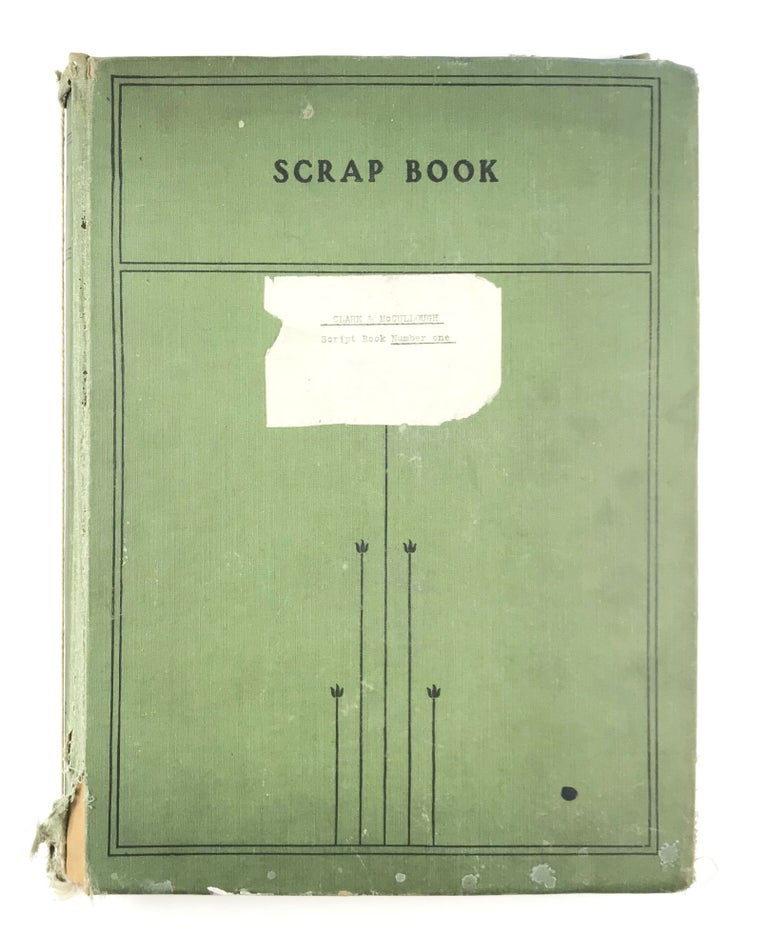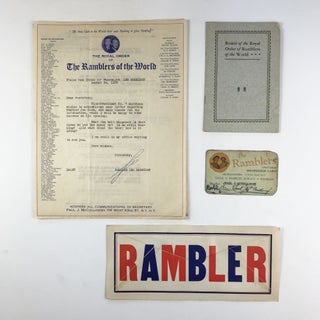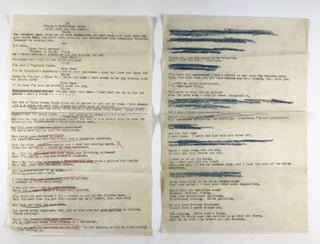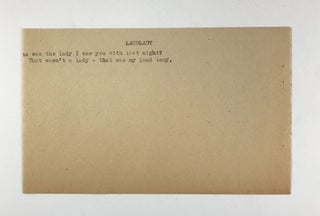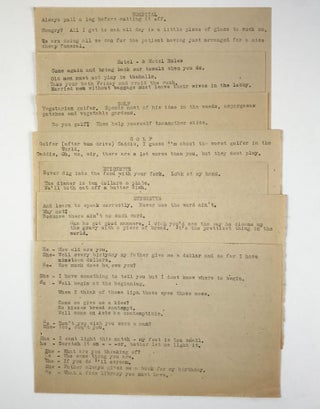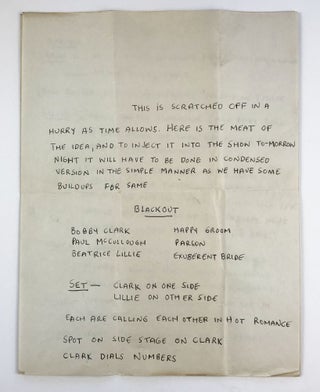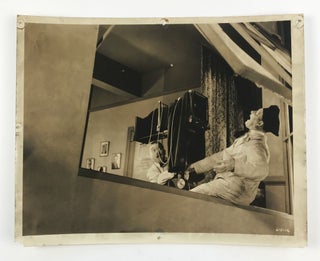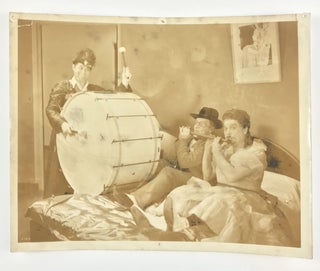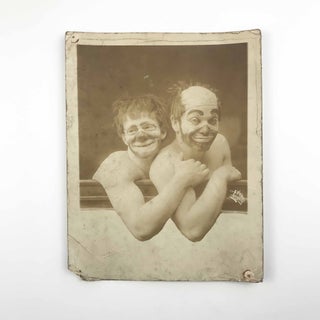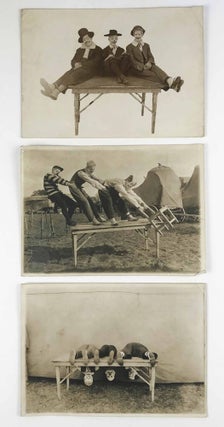Archive
Various Places: nd [c. 1900's-40's]. A substantial archive of materials relating to the early 20th century performing artists Clark and McCullough, documenting their protean trajectory across a wide swathe of 20th century popular theatrical forms- from Minstrelry to Circus to Vaudeville to Burlesque to popular film.
The two had been high school friends in Springfield, Ohio, where they learned tumbling and gymnastics together at a local YMCA. McCullough was older by five years, and would eventually become the “straight man” to Clark, who was one of the most forceful slapstick performers of his day, a perfomer who oozed darkness and agitation and black humor in a manner that pushed the edges of acceptance, and whose trademark was eyeglasses drawn
directly on his face.
After leaving school, they joined the minstrelry circuit, which they left early in their careers after two very odd encounters with the tonsorial arts led them to abandon minstrelry. The presense or absence of barber’s would overshadow their careers in a macabre and fantastic manner. The two subsequently joined the Hagenback circus with money taken “under duress” from the latter barber, the start of a successful career as circus clowns for Ringling Brothers and other circuses.
By 1912 the two took their character acts to the vaudeville circuit, where they worked until their participation in the White Rat Strike of 1916 lead them to become blacklisted by the Vaudeville Managers Association. The two subsequently hit the burlesque circuit, where they achieved much greater fame. In 1922 Irving Berlin saw them perform, and signed them up to headline his Music Box Revue - a break that saw them become headlining musical stars on the White Way. Their 1926 show The Ramblers was adapted by Wheeler and Woolsey into their hit movie The Cuckoos, and in 1928 the two signed with Radio Pictures and began to release a staggering number of films during the summer months, while working on Broadway at other times. The routines which the duo performed were characterized by their fast pace and dark sense of humor (one of their films involves cooking a pet dog and feeding it to the owner). McCullough’s work as the straight man is noticeably subdued in these films, and his lines and time shrank in relation to Clark, while the demonic intensity of Clark’s gags on screen often come across as threatening rather than entertaining - a dark act that was perhaps ahead of its time. Though the duo made at least 38 films, their remarkable successes on all variety of stage had some difficulty translating to the screen, garnering mixed critical attention. The dark slapstick of their 1935 film, Alibi Bye Bye, in which the duo play alibi photographers who take photographs of subjects in artificial settings to use as photographic proof of travel, and which ends with violence, is a good representation of their dark American slapstick. It would be their final film.
In early 1936, McCullough checked into Massachusetts sanitarium. Clark was there to pick him up when we was discharged, and on the drive out McCullough asked to visit a barber. After getting his haircut, McCullough seized the barber's razor and killed himself by slashing his neck and wrists.
It was a horrible and ironic end for the performer, as an early 1920’s article in a Cincinnati newspaper, entitled “Barbers and Comedians: Tonsorial Artists Had a Part in Shaping the Careers of Noted Comedians,” included in one of the scrapbooks, was entirely devoted to how the career of the duo had been affected by barbers since their very beginning. The first minstrel troupe which the two had joined had broken up because of the lack of a barber. When the
troupe arrived in Altoona, the barber shop had already closed for the night, yet their cornet player was too hirsute to perform. Clark offered to shave the musician, but accidentally cut off part of his lip, making it so that he could no longer play his instrument, and the troupe broke up after the resulting fight.
The two also joined the circus because of a barber, when a tonsorial artist bought a failing show which the two participated in, and the article hints that the two took $4 from the man “under duress”, and used the money to get to Atlanta where they joined the Hagenbeck circus, the beginning of their time in the circus.
A description of the archive, which fills two banker boxes, follows.
A. Scrapbooks.
Two commercial scrapbooks, each 144 pp. long. The first documents the career of the duo, and is almost completely filled, with ticket stubs, newsclippings, photographs, contracts, programs, correspondence, and promotional materials. Some of the latter material in this scrapbook includes humorous jokes and materials from newsclippings, perhaps for inspiration. In this section several of the leaves are filled on the recto only, but the rest of the album is filled on both recto and verso.
The second scrapbook is about 2/3 filled, and, aside from a pasted in ribbon, is mostly newsclippings related to their breakthrough show The Ramblers.
B. Typescripts, Manuscripts, & Scripts.
1. Clark & McCullough Script Book Number One. Folio 14 1/2 x 11”, [144] pp, commercial scrapbook with typewritten title label pasted down to front panel. The scrapbook is completely full of pasted down scripts, songs, and scenarios, some typewritten, some mimeographed or duplicated, some with holograph additions and corrections. Some of the material within is attributed to Irving Berlin, one page which is entitled “Hell Finale of First Act” and is based around the song “Pack Up Your Sins,” but with a number of additional lyrics and dialogue, some crossed out or with holograph corrections.
2. Loose Scripts and Other Texts. 47 sheet sheets, mostly foolscap, typewritten or duplicated from typescript, mostly on onionskin paper. Margely script. Of special note is a 3 pp. holograph script written in an unknown hand for an untitled act with Clark & McCullough with the great Beatrice Lillie, beginning with a note stating “This is scratched off in a hurry as time allows. here’s the meat of the idea, and to inject it into the show tomorrow night…” Another sheet features a dittoed version of the James Whitcomb Riley poem which begins “When the booze is in the bottle… with textural differences form either the version published in Bruno’s Weekly or the handwritten manuscript at the Riley archive at Indiana State.
3. Joke and Gag cards. 128 cards, each approximately 5 x 7 1/4”, typewritten, some on both sides, with occasional holograph corrections. Most of the cards print jokes and gags, usually several to a page, but there are also several scenarios included.
C. Materials Relating the Fraternal Organization “The Royal Order of the Ramblers of the World.”
Thus hob-themed organization appears to have been started by Clark & McCullough. One membership card features a photograph of the duo, for which Clark was the president, and McCullough the secretary. We can find very little published documentation of the order, but it seems to have been fairly large - membership was capped at 500 members - and it included a number o fhigh profile members in the performing arts and literary world at the time, including Irving Berlinl Damon Runyon, Jack Lait, Eddie Cantor, and Arthur “Bugs” Baer. Their official song was “He Rambled,” which ends with the line “He Rambled Till the Butchers Cut Him Down.”
1. Roster of the Royal Order of Ramblers of the World. 16mo, 12 pp, saddle-stapled wraps. Booklet listing members, with the articles of the club listedn inside back cover.
2. Two membership cards for the organization.
3. 20 items of correspondence, mostly TLS or ALS, all between club members, including one card with a tipped-on photographic portrait of Harry Tate. Several of the letters are printed on club stationary, including an extensive list of offices and leadership.
4. Miscellaneous printed materials, one a color lithographed “Ramblers” envelop, and one a blank and unsent Ramblers Christmas card by McCullough to be sent to fellow Ramblers.
D. Correspondence.
Approximately 30 items, TLS or ALS, many with the original envelopes included, housed in sleeves in a three ring binder.
Correspondents include other acts, such as the Boxcar Duo, and other miscellaneous topics. Of special note is TLS from the publisher Lowell Brentano, indicating interest in a manuscript after a change meeting on a train between the duo and Brentano’s sales manager, etc.
E. Photographs.
1. Press and promotional photographs, approximately 135, mostly from Clark & McCullough films, mostly 8 x 10”.
2. 23 Miscellaneous photographs of various dimensions, mostly 8 x 10” or larger, some inscribed. Includes inscribed photographs of Oscar Shaw, Harry Rosenthal, John Steel, Joe Cook, and Jack Whiting. Includes a couple small snapshots, one which appears to show a very early performance by the duo, and one early group portrait snapshot that appears to show a circus crew.
F. Miscellaneous Printed Materials.
47 membership cards and licenses, many of them related to circus or theatre, 8 copyright certificates from the Library of Congress, two contracts, a stock offering, 3 cancelled checks, and 13 printed brochures or leaflets. Item #26713
Price: $12,500.00

